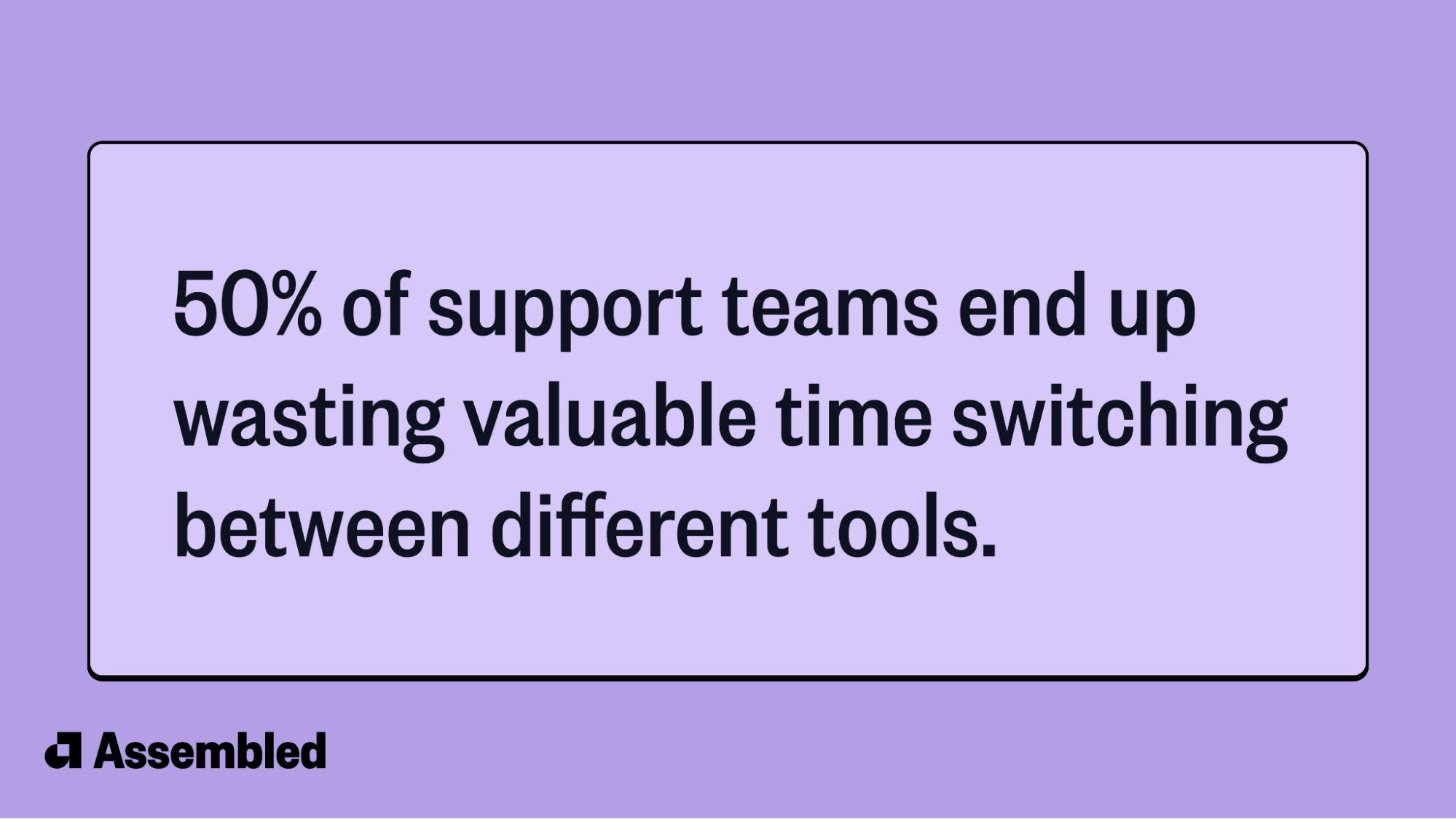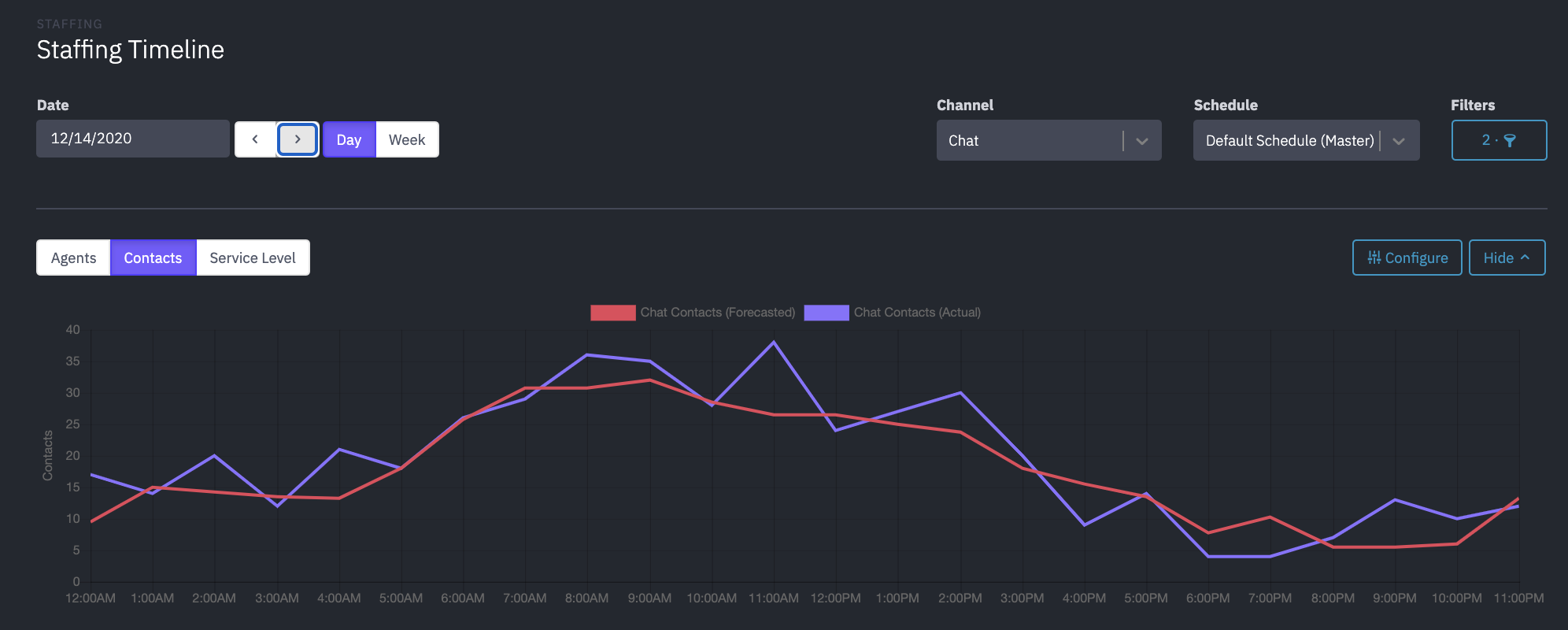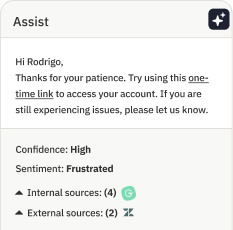7 Assembled WFM features that are changing customer support for good

When it comes to overseeing a customer support team, you’re not only spinning a lot of plates, but also a lot of mugs, bowls, platters, and saucers. It’s a role that requires being a master of complex problem-solving in an agile environment. And as your team scales, you can count on adding just about every other type of tableware to the mix as well.
It might not always be easy, but with the right approach and a bit of help from a workforce management (WFM) platform, you can become a plate-spinning expert in no time.
Whether you’re just beginning to explore WFM tools or you already have an idea of what you’re looking for, it’s important to make sure you choose a solution with key features, such as scheduling that accounts for agents’ lunch breaks and integrations with platforms you already use.
Common challenges customer support teams are facing
For today’s support teams, even small and mighty ones, it’s no longer enough to give customers a single email contact to request help with an issue. Providing support via email is easiest, but there are many customers who prefer to communicate via chat, phone, or even social media.
While many companies are working toward being able to provide omnichannel support, a Zendesk report reveals that only 50% of companies have achieved that goal. Why? If you’ve gone through the process of launching one or more live channels, you know just how difficult it is. Text and phone are more personal than email, which means agents often need specific training to navigate conversations on those channels.
This also relates to another challenge we uncovered in our State of Customer Support Software Survey: improving agent interactions. When asked, “What's the #1 problem you are facing in CX that is not currently addressed by a tool?” 17% of respondents mentioned difficulty with agent productivity, performance, and development. Understandably, this becomes more of a struggle as you grow your team, especially in an increasingly remote environment.
Meeting customer expectations as a whole is also something many support teams are working hard to address. This is especially challenging when you consider how high the bar is set today.
According to recent research from Microsoft, customers say the most important aspect of a good service experience is having their issue resolved the first time. On top of that, 58% of customers will end their relationship with a business that doesn’t provide good service. No pressure or anything. 😅
Lastly, customer support leaders often have issues finding the right tools for their needs. A report from Intercom shows that 50% of support teams find themselves wasting time jumping between different tools. In fact, only 37% of the support professionals polled are satisfied with the solutions their team currently has in place. This just goes to show that without a fully integrated technology ecosystem, teams run into both inefficiencies and frustrations.

7 Assembled workforce management features helping support teams thrive
We’ll never claim to be a perfect workforce management solution for every support team, but at Assembled we’re constantly striving to improve our platform. In fact, one of our core values is “1% better,” meaning we strive to make a bit of progress each and every day. That’s why we regularly roll out new features that can help leaders like you rise above the challenges and help your support team shine. ✨
While Assembled is packed with powerful WFM solutions, we’ve rounded up the seven essential features that are truly revolutionizing customer support.
1. SOC 2 compliance
Security compliance is about more than just checking items off a to-do list — sensitive data is at stake. Breaches that have exposed personally identifiable information have tarnished organizations’ reputations, sometimes nearly instantly.
When Assembled obtained the SOC 2 Type II certification at the beginning of 2021, it was a huge step forward in our relentless pursuit to provide you with a top-of-the-line WFM solution. It shows that we passed a detailed assessment by the American Insitute of Certified Public Accountants (AICPA) related to the security, availability, and integrity of the systems Assembled uses to process and stores user information.
While customers may not cite a business’s security standards as critical to their overall experience, it’s very much implied. When customers provide you with their information, they’re indicating they trust you to protect it. A breach that exposes customer data, even one that occurred through no fault of your own, violates a fundamental customer experience standard.
Security compliance might not be sexy, but it’s vital in today’s digital world.
2. Time tracking for Zendesk Support
Time tracking feels like a necessary evil for many agents, especially if they’re providing email support. When their activities are boiled down to just “online” or “offline,” managers don’t get a true picture of how agents spend their time. An agent could easily appear to be out of adherence if they’ve navigated to a tab outside of Zendesk — a knowledge base, for example — to find the correct answer to a customer question.
Assembled’s Zendesk Support time tracking feature provides more information about the different types of activities agents perform throughout the day. This gives managers greater visibility into how agents are spending their time, and it certainly lessens the pressure agents feel to hit benchmarks that might not be realistic for a particular situation.
With additional context on how agents are actually spending their time, they can focus on their work instead of worrying about making a mistake or appearing as though they’re off-task. This is a huge point of differentiation between Assembled and other WFM tools, something Care/of learned the hard way. 😬
“Even though Tymeshift integrated with Zendesk, it was buggy. Worst of all, our agents felt like they were being watched because of how adherence worked. Tymeshift created a really weird dynamic on our team, where agents felt managed by the tool.”
HANNAH SANTISI, CX TEAM LEAD AT CARE/OF
3. Integration with UJET
Having a 360-degree view of the customer isn’t just a nice-to-have in customer support — it’s essential for providing the types of personalized experiences that the modern customer has come to expect. Assembled’s UJET integration aims to do just that by bringing all data from different channels together in one platform and allowing teams to automate scheduling, create accurate forecasts, and see actionable reporting all in one, easy-to-use interface.
To build out this integration, Assembled worked directly with the UJET team. This highly collaborative approach ensured every detail was taken into account, allowing teams to quickly onboard in Assembled.
4. Event Optimizations
No agent spends every second of their working day responding to customer inquiries. They also need breaks, a dedicated time to eat lunch, time to work on other projects, and so on. But scheduling those events in spreadsheets is more than even the most talented support manager can handle.
This is why we launched Event Optimizations, a feature that lets you build in non-productive events based on a set of rules that you set. Rules? Think the length of lunch breaks and the ability to prioritize team meetings over professional development projects.

The way Assembled accounts for activities outside of responding to customers not only helps to balance support needs and internal team needs, but also saves valuable time. This is something GoFundMe quickly realized after implementing Assembled.
“The daily algorithm spits out 80-90% of the schedule for us, which saves us over 2 hours a day in scheduling. Every day it’s tangible savings.”
MORGAN WOOD, VP, CUSTOMER OPERATIONS AT GOFUNDME
Ask yourself: What could you do with two hours back each day?
5. Assembled App for Zendesk
As we mentioned earlier, switching between tools is a huge issue for many support teams. There are tons of great tools out there — and they’re getting better every day — but just think how much better a team of highly skilled agents would be with a more connected technology ecosystem. This is even more true when an agent is leveraging tools while simultaneously speaking to a customer who needs an issue resolved.
The issue of needing to switch between tools is compounded if teams are using a separate tool for every channel of communication, which is incredibly common. In fact, 31% of teams that manage three types of channels rely on three distinct tools to do so.
With the Assembled App for Zendesk, we nipped this problem in the bud. Now, agents can see all the information they need within a single window, so they never have to leave their usual workflow. Ahh, finally.
Another advantage of this app? It provides real-time updates on schedule changes and reminders for upcoming events with pop-up notifications within Zendesk. This shows support teams exactly what changed at the moment it changed.
6. Staffing Timeline 2.0
Determining whether you’re overstaffed or understaffed can be challenging if you’re running calculations and manually updating a static spreadsheet. You also run into visibility issues — managers have trouble determining when it would make the most sense to have an all-hands meeting and agents lack a big-picture view that could otherwise give them context into why certain scheduling decisions were made.
From the start, Assembled’s Staffing Timeline made it easy to calculate staffing needs with configurations and allowed managers to conduct what-if analyses to determine how different factors would affect those needs. That all came together in the chart you can see below, which clearly provides a view of forecasting and staffing requirements, making it clear when teams are overstaffed or understaffed.

The updated Staffing Timeline keeps everything teams loved about the original one, but it enables a more intuitive and efficient staffing experience. Now, you can view multiple timezones at once (you read that right), set custom range views, and edit events in bulk. You can also leverage the new search bar to quickly find specific agents. And because we’re all about efficiency, we’ve created dozens of keyboard shortcuts. Switching costs? Not here!
7. Updated onboarding
Anyone who heavily relies on technology to do their jobs — 12/10 working professionals today — knows the best way to get familiar with a new tool is to dive right in and start experimenting. But this tactic only works if you have the fundamentals down first.
To make sure support teams who are new to Assembled have the basic building blocks down, we launched an updated onboarding experience. It makes life easier for support teams by allowing you to import users and data with one click, more accurately map agent states, and easily organize queues however you want.
Mobile travel-booking company Hopper has used Assembled's queue mapping functionality to good use, splitting out support volume by product line. It enables each business unit to target their own SLAs and optimize staffing accordingly. They can also review historical information to get an understanding of product costs.
“It's been invaluable to look at historical tasks and the hours assigned to each. It helps us understand the percentage breakdown for different business units and product lines. Regardless of any circumstances, how many hours were assigned to a given product, and what's the breakdown of the total?”
JOANNA LAI, HEAD OF CUSTOMER EXPERIENCE AT HOPPER
Onboarding should be a breeze — not a burden.
Find out how Assembled can transform your team
The above features are all useful, but we're just scratching the surface here. We always have new releases on the horizon to ensure support teams have everything they need to be successful, often inspired by what we hear from our customers. Just like your agents, we value what customers say and are prone to take action. At Assembled, we see feedback as a gift that helps us improve our platform just a bit each day — we really mean it when we say one of our key values is “1% better.”
This relentless pursuit toward progress has earned Assembled rave reviews on G2 and Capterra. We’ve also heard directly from our customers. Take a look at our customer stories from leading brands like Casper and Stripe to discover how the platform gives support leaders greater visibility into staffing needs, a hub for streamlining their operations, and more. And stay tuned! We’ve got some exciting things brewing in the new year.
Ready to make 2022 the best year for your support team? Book a demo to get a behind-the-scenes look at Assembled to see how we can help your team thrive👇 Our team is more than happy to walk you through the ins and outs of the platform.





